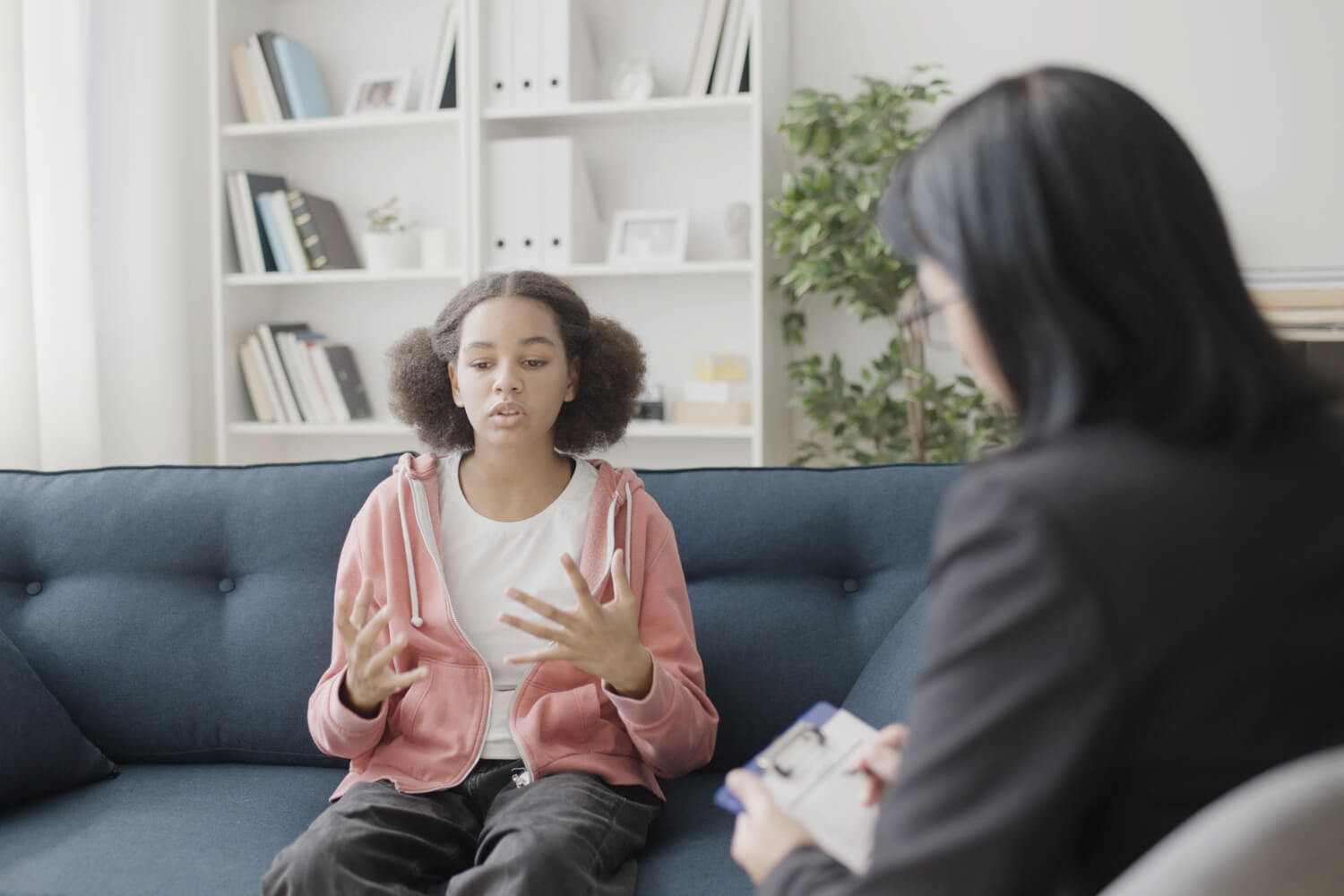Essential ways Therapists For Teens integrate different therapy types to help struggling youth
Discovering the Different Sorts Of Therapy Available for Teenagers With a Therapist for Teens
Teenagers face unique obstacles that can impact their psychological wellness. Numerous healing methods are tailored to address these problems properly. From Cognitive-Behavioral Therapy (CBT) to Art Therapy, each modality offers distinctive benefits. Comprehending these treatments can help caretakers make educated choices. What factors should be considered when choosing the best method for a teen? The exploration of these various treatments discloses understandings that can significantly enhance teen health.
Recognizing Cognitive-Behavioral Treatment (CBT) for Teens
Cognitive-Behavioral Therapy (CBT) works as a powerful device for addressing the one-of-a-kind mental wellness obstacles faced by teens. This evidence-based method focuses on the interaction between behaviors, sensations, and ideas, assisting teens identify and transform unfavorable idea patterns that add to their struggles. Through structured sessions, therapists guide young adults in recognizing their cognitive distortions, fostering healthier coping systems and emotional guideline.
CBT is especially reliable in handling stress and anxiety, depression, and behavioral concerns, as it equips teenagers with sensible skills to navigate their lives. The therapy encourages self-reflection and promotes a positive attitude, equipping teens to take control of their psychological health and wellness trip. By establishing details goals and using numerous methods, such as journaling and role-playing, CBT fosters strength and self-awareness. In general, this restorative strategy provides teens with essential tools to face their difficulties and develop an extra favorable expectation on life.
The Advantages of Dialectical Behavior Modification (DBT)
While lots of healing approaches offer important understandings for teenagers, Dialectical Behavior Therapy (DBT) attracts attention for its efficiency in resolving psychological law and interpersonal difficulties. Established by Dr. Marsha Linehan, DBT combines cognitive-behavioral techniques with mindfulness practices, making it especially ideal for teens coming to grips with extreme feelings. This treatment helps teenagers determine and recognize their feelings, advertising healthier reactions to stress factors.
Among the substantial benefits of DBT is its concentrate on structure abilities in four key areas: mindfulness, social efficiency, distress resistance, and psychological policy. These skills empower teenagers to navigate complex connections and deal with tight spots much more efficiently. Additionally, DBT urges a solid therapeutic partnership between the specialist and the teenage, promoting depend on and openness. Therefore, many teenagers experience enhanced psychological security and boosted coping systems, ultimately bring about a much more fulfilling life and more powerful partnerships with peers and family.
Discovering Art Treatment as an Innovative Outlet
Art therapy provides teens a distinct method for self-expression and psychological exploration (Youth Counsellor). With numerous methods and techniques, it enables them to connect sensations that might be tough to verbalize vocally. By participating in imaginative activities, teenagers can experience therapeutic benefits that promote psychological health
Benefits of Art Therapy
Participating in art treatment offers teenagers with a special imaginative outlet that promotes psychological expression and individual understanding. This therapeutic method enables adolescents to interact sensations and experiences that may be difficult to articulate verbally. With different kinds of imaginative expression, such as drawing, painting, or sculpting, teens can check out and refine complex emotions, leading to enhanced self-awareness. Furthermore, art treatment promotes relaxation and stress and anxiety alleviation, supplying a safe room for individuals to release suppressed feelings. The non-judgmental environment urges experimentation, assisting teens build self-confidence in their creativity and analytical abilities. Therefore, art therapy can improve general mental wellness, offering a valuable tool for managing life's difficulties during this important developing stage.
Techniques and strategies
When checking out art therapy as an imaginative electrical outlet, numerous methods and methods can be employed to facilitate psychological expedition and expression. These may consist of illustration, sculpting, collage-making, and paint, enabling teens to interact sensations that may be difficult to express vocally. Led imagery can additionally be made use of, motivating people to visualize and develop representations of their feelings. Additionally, the incorporation of songs or activity can boost the creative process, promoting a much deeper link to their inner experiences. Team art activities provide opportunities for social communication and shared recovery. Significantly, the focus in art treatment exists not on artistic ability but on the process of development, empowering teens to uncover their own one-of-a-kind types of self-expression and insight.
Art as Expression
Creative thinking acts as a powerful channel for self-expression, specifically for teenagers navigating complicated feelings. Art treatment uses a special electrical outlet for teenagers to discover and interact sensations that may be difficult to express verbally. Via drawing, painting, or sculpting, teenagers can visualize their internal battles, fostering a feeling of understanding and launch. This healing strategy permits personal analysis and motivates exploration without judgment. Furthermore, participating in innovative activities can increase self-worth and promote emotional resilience. As teenagers produce, they may locate brand-new perspectives on their challenges, resulting in recovery and individual development. Eventually, art therapy acts as a necessary resource, equipping teenagers to browse their emotional landscapes through innovative expression.
The Duty of Family Members Therapy in Teenager Mental Health

Benefits of Family Members Participation
:max_bytes(150000):strip_icc()/what-is-cognitive-behavioral-therapy-cbt-2610410_final1-a83b26973a69405ab2dbbc1c8ecda1f6.png)
Communication and Problem Resolution
Efficient interaction and conflict resolution are essential parts of teen mental wellness, particularly within the context of household treatment. Family therapy gives a structured atmosphere where teens why not find out more can reveal their ideas and feelings, cultivating open dialogue. This restorative setup motivates member of the family to actively listen per other, advertising understanding and empathy. By addressing problems in a secure space, teens learn useful abilities for handling disagreements constructively, which can decrease psychological distress. In addition, these abilities improve family members characteristics, resulting in healthier relationships. As teens navigate the intricacies of their feelings, household treatment equips them with tools to connect effectively, willpower disputes amicably, and reinforce domestic bonds, ultimately supporting their general mental health.
Using Mindfulness-Based Therapy for Stress Reduction
As teenagers navigate the intricacies of adolescent life, including mindfulness-based therapy can serve as a powerful device for stress reduction. This restorative approach emphasizes present-moment recognition, aiding teens confront their ideas and feelings without judgment. By practicing mindfulness techniques such as deep breathing, body scans, and directed imagery, adolescents can learn to handle anxiousness and stress and anxiety better.
Research suggests that mindfulness-based treatment can improve psychological regulation and durability in teenagers, allowing them to deal much better with scholastic stress and social obstacles (Therapists For Teens). Routine technique can lead to improved focus, minimized impulsivity, and higher general wellness. In addition, mindfulness promotes a sense of connection to oneself, advertising self-compassion and minimizing negative self-talk
Integrating mindfulness into therapy sessions offers teens practical strategies they can use in day-to-day life, empowering them to browse stressors with better simplicity and self-confidence. As an outcome, mindfulness-based treatment ends up being an essential source in sustaining adolescent mental wellness.
Integrating Play Treatment for Younger Teenagers and Preteens

Therapists learnt this approach develop a safe environment where more youthful teens can discover their issues and develop dealing strategies. By engaging in play, these people can much better understand their emotions and discover to navigate social interactions. In addition, play treatment can cultivate strength and problem-solving abilities, necessary for browsing the challenges of teenage years. On the whole, integrating play treatment can boost the healing procedure, providing younger teens and preteens with the tools they need to prosper psychologically and socially.
Often Asked Inquiries

How Do I Know if My Teenager Demands Therapy?
Indicators that a teen may need treatment consist of relentless sadness, modifications in behavior, withdrawal from activities or buddies, scholastic decrease, boosted stress and anxiety, compound use, or difficulty managing life changes. Observing these indicators can motivate specialist evaluation.
What Credentials Should I Look for in a Teen Specialist?
When read this looking for a teen therapist, one must focus on certifications such as appropriate levels in psychology or therapy, state licensure, specialized training in adolescent issues, and experience working with teens in different restorative settings.
How Can I Support My Teen During Treatment?
To sustain a teenager throughout therapy, one need to actively pay attention, use motivation, regard their privacy, and verify their sensations. In addition, cultivating open communication can assist them really feel a lot more comfortable discussing their experiences and emotions.
What Are Common Indicators of Mental Wellness Issues in Teenagers?
Usual signs of mental wellness issues in teens consist of consistent despair, withdrawal from activities and buddies, modifications in rest or cravings, problem concentrating, raised irritability, chemical abuse, and obvious declines in academic performance or self-esteem. (Youth Therapist)
For How Long Does Therapy Generally Last for Teenagers?
Therapy duration for teens generally varies, often lasting from a couple of weeks to several months. Aspects affecting this timeline consist of the individual's certain needs, the kind of treatment, and progression made during sessions.
From Cognitive-Behavioral Treatment (CBT) to Art Therapy, each modality uses distinct advantages. Cognitive-Behavioral Treatment (CBT) offers as a powerful tool for dealing with the unique mental wellness challenges encountered by our website teenagers. Engaging in art treatment offers teens with an one-of-a-kind creative electrical outlet that fosters psychological expression and personal insight. Family treatment provides an organized environment where teens can express their feelings and thoughts, cultivating open dialogue. Research study indicates that mindfulness-based treatment can enhance psychological law and strength in teens, allowing them to cope better with social difficulties and academic pressures.